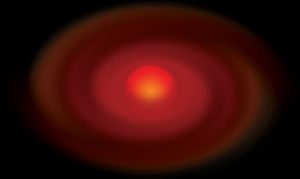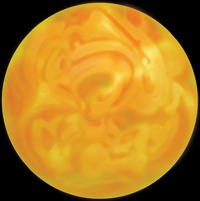The Lives of Stars
Working out the life cycle of stars was the work of many eminent astronomers.
The result is one of the great scientific achievements of the Twentieth Century.

Starfield. Hubble Space Telescope, NASA/ESA
In this blog we will trace the lives of stars from their birth to their brilliant prime.
In our next blog we’ll see how stars die.
Star Factories
All stars are created in huge clouds of gas and dust called nebulae.

The Orion Nebula. NASA/Hubble
An emission nebula like the Orion nebula glows red.
This colour comes from hydrogen gas, lit by the stars within it.
A nebula is made of around 90% hydrogen, the lightest element.
The rest is helium plus traces of nitrogen, oxygen, carbon and heavier elements.
Star Birth
The force that creates stars is gravity.
The fuel that makes stars shine is hydrogen.
As gas and dust swirls in the nebula, one part become denser than the rest.
This can happen at random.
Or it might be caused by the pressure of a nearby exploding star.
The denser area has greater gravitational pull.
It draws in gas from around it.
The gravity increases and more gas is pulled in.
This part of the nebula begins to collapse and form a star.
Protostar
The temperature rises as the gas is compressed.
After about a million years, it is a hot, glowing ball of gas.
It has become a protostar – not a star yet, but on its way.

Protostar. NASA / Chandra
A star is born
After several million years, the temperature at the centre of the protostar
reaches ten million degrees.
This is a critical temperature and everything changes.
At 10 million degrees, hydrogen atoms fuse together to create helium.
The fusion reaction gives out enormous amounts of energy.
A star is born. it begins to shine, to radiate energy.

Sun type star. NASA/Chandra
Only the centre of the star, the core, reaches 10 million degrees.
This is the powerhouse of the star, its energy producer.
The gas outside the core, in the shell, does not reach 10 million degrees.
It cannot fuse but keeps collapsing inwards under its own gravity.

Forces inside a star. Dennis Ashton
The star achieves balance.
The radiation force from the core is balanced by the squeeze of gravity from the shell.
The ball of hydrogen is now a bright active star.
It is called a Main Sequence star.
The Sun is a typical main sequence star.

The Sun, a star. Photo: NASA
The future of every star is decided by the opposing forces of radiation pressure and gravity.
Star Lives
Stars will shine for millions, billions of years.
There is enough hydrogen in their cores to sustain their long life.
The length of an individual star’s life depends on its mass, how much hydrogen it contains.
But it may not be in the way you imagine.
Red Dwarfs
Red dwarfs are the most common stars in our universe.
They account for three-quarters of stars in the Milky Way.
We don’t see them simply because they are very dim.
Their surface temperature is around 3,500 degrees C.
And, as their name suggests, they are smaller than the Sun.
The nearest star to the Sun is a red dwarf.
It is Proxima Centauri, the smallest of a trio of stars.

Sun and Proxima Centauri. Graphic: Dennis Ashton
Red dwarf stars burn up their hydrogen at a slow rate.
They last for many billions of years.
A red dwarf with a mass of one-tenth of our Sun will last 1000 times longer.
It has a lifetime that will stretch to 10 trillion years.
So red dwarfs have a lifetime longer than the age of the universe so far!

Red dwarf with planet. Image NASA / D. Aguilar/Harvard-Smithsonian Center for Astrophysics
Some exoplanets have been found in orbit around red dwarfs.
Star Gliese 876, just 15 light years away, has four planets in orbit around it.
Could there be life on planets belonging to these long-lasting stars?
Sun-type stars
Stars similar to our Sun account for most of the stars visible in our night sky.
They will last for billions of years.
Our Sun’s life span is 10 billion years.
It is now around 5 billion years old so it has another 5 billion years of life remaining.

The Sun. Photo: NASA
Many Sun-type stars are bigger and brighter than the Sun.
Sirius, the ‘dog star’ is the brightest night-time star.
It is about twice the mass of the Sun and shines 25 times brighter.

Sirius in the winter sky. Image: Stellarium
When these common stars die, their death is dramatic but relatively gentle.
Blue Giant stars
The biggest stars weigh in at around 100 times the mass of the Sun.
They are massive, hot and blue: blue giant stars.
They are uncommon, making up only one percent of stars in the Milky Way.

Blue giant star. Credit: NASA
These superstars shine thousands of times brighter than our Sun.
The star Rigel in Orion is a blue giant.
It shines 50,000 times brighter than the Sun!

Rigel in Orion. Credit: Stellarium
The biggest stars have the shortest lives.
They burn up their hydrogen very fast.
They only last a few million years, a thousand times less than the Sun.
And when these stars die, they go in dramatic fashion.
They explode!
Coming next
In this blog we have seen how stars are created by gravity in huge clouds of gas.
They shine because of nuclear fusion reactions in their cores.
But within every star there is contest between radiation and gravity.
Next time we’ll see what happens when stars run out of fuel.
The battle between radiation and gravity reaches its climax.
We’ll discover how stars die.
The author: Dennis Ashton is a Fellow of the Royal Astronomical Society and a Wonderdome presenter.
Would you like to hear more Astronomy news?
Do you want to to find out about our upcoming public events?
Follow WonderDome Portable Planetarium on Twitter and Facebook or go to our web site wonderdome.co.uk!

